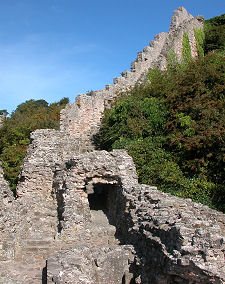 Berwick-upon-Tweed: Edward III Was a Frequent Visitor |
King Edward III of England lived from 13 November 1312 to 21 June 1377. One of the most successful English monarchs of the middle ages, he turned England into a major European power. The wider picture in Scotland at the time is set out in our Historical Timeline.
Edward III was born at Windsor Castle, the eldest son of King Edward II and Queen Isabella. In his early years he was known as Edward of Windsor. On 24 January 1327, when Edward was 14, his mother and her lover Roger Mortimer, 1st Earl of March, forced the imprisoned Edward II to abdicate in favour of his son, and thereafter ruled the country as Regents in the name of Edward III. On 11 October 1327 Edward II was murdered while a prisoner at Berkeley Castle in Gloucestershire, leaving the country in the effective control of Isabella and Mortimer.
On 24 January 1328 the sixteen year old Edward III married fourteen year old Philippa of Hainault at York Minster. From a Scottish perspective the major development during the Regency of Edward III was the Treaty of Edinburgh and Northampton, under the terms of which the English renounced their claims over Scotland in return for a payment of £20,000 Sterling. Meanwhile Mortimer effectively ruled England for his own benefit, earning the dislike of many powerful people in the country and the hatred of the young Edward.
On 19 October 1330, a group of supporters of Edward III burst into Nottingham Castle, where Mortimer and Isabella were sleeping, arrested them and took them to the Tower of London. The 17 year old Edward laid fourteen charges of treason against Mortimer, including the murder of Edward II. He then, without a trial, condemned Mortimer to death despite the pleas of Isabella, who was pregnant with Mortimer's child. Mortimer was executed a month later and Isabella was exiled to Castle Rising in Norfolk where she miscarried.
Robert the Bruce of Scotland died on 7 June 1329 and was succeeded by his four year old son David II. Edward III backed an invasion of Scotland by Edward Balliol, son of King John Balliol, which resulted in Edward Balliol being crowned King of Scotland at Scone in September 1332. By the end of the year, however, he had been beaten back by Scottish nobles loyal to David II led by Sir Andrew Murray and retreated to England. In 1333 Edward III, having formally renounced the Treaty of Edinburgh and Northampton, launched a major invasion of Scotland in support of Edward Balliol. Further conflict followed in 1334/5 and 1336/7. The pattern of what became known as the Second War of Independence was one of overwhelming English invasion which repeatedly captured large parts of Scotland but failed to conquer the country, interspersed with period in which the Scots slowly regained territory. When Edward Balliol was chased out of Scotland in 1337 he again turned to Edward III for support, but this time found him otherwise occupied.
In 1337 Philip VI of France, an ally of the Scots, confiscated English territory in Aquitaine and Ponthieu. Edward III responded by laying claim to the Crown of France as a descendent via his mother of Philip IV. The scene was set of what would later be called the Hundred Years' War. Edward III had a number of significant successes against the French during the 1340s, including the Battle of Crecy and the capture of Calais. In 1356, Edward's oldest son, Edward, the Black Prince, won a significant victory at the battle of Poitiers and captured King John II of France. The crown of France seemed within Edward III's reach, but in 1360 he signed the Treaty of Brétigny, under which he renounced his claims to the French throne in return for gaining full sovereignty over his extensive possessions in France. Achieving this rather than the crown of France may have been his aim all along.
In 1346 David II of Scotland had launched an invasion of England in support of France. It culminated in the disastrous Battle of Neville's Cross on 17 October 1346 at which David was captured. Edward Balliol again took the opportunity to invade Scotland, but this proved even less successful than his earlier attempts to control the country. On 20 January 1356 Balliol relinquished his claim to the Scottish crown to Edward III of England in exchange for an English pension. Edward III was playing a bigger game in France at the time, and in any case still held David II of Scotland as captive, so paid little attention to Scotland. David II was released in 1357 in return for a huge ransom paid by Scotland and the acknowledgment that Edward III was his feudal superior.
Edward III died on 21 June 1377, having ruled for over 50 years. The last 15 years of his reign were marked by a reduction in personal drive and involvement which saw the French recapture many of the English possessions in France, while an attempt to gain control of Ireland largely failed. Nonetheless, Edward is remembered as a highly successful king, whose military achievements were matched by significant developments in government and legislation, especially following the Black Death of 1348, when plague killed up to a third of the population of Europe.

